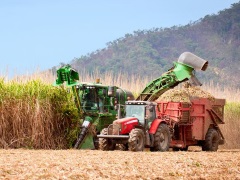Features
Bolstered reputation
Date: 2017-10-31 10:02:47.0
Author: Jon Evans

Harvesting sugarcane in Brazil.
Credit: Depositphotos photo by Jaykayl.
For several years now, biofuels have seen their reputation take a bit of a battering. Critics have repeatedly questioned their environmental credentials, arguing that the energy required to grow biofuel feedstocks and then convert them into liquid fuels means they produce just as much carbon emissions as petroleum-based fuels. They’ve also questioned the wisdom of growing crops such as corn and wheat for biofuel production rather than for food, arguing that this can push up the cost of food.
These two criticisms were then combined in the concept of indirect land use change, in which growing biofuel feedstocks requires the creation of new arable land for growing displaced food crops, releasing extra carbon in the process. Critics have even had a go at cellulosic biofuels, which sidestep many of the fuel versus food issues, by suggesting that it would be more efficient to burn the biomass to produce electricity, rather than try to convert it into liquid fuels.
Now, though, two new studies go some way towards restoring the tarnished reputation of biofuels. Using new, more detailed models and up-to-date information, these studies find that some of the criticisms have been overblown, and that biofuels can help to reduce global carbon dioxide emissions without having a detrimental effect on food production.
The first study, conducted by a team of researchers from the US, Brazil and Denmark, looked at growing sugarcane as a biofuel feedstock in Brazil. Sugarcane is already the biofuel feedstock with perhaps the best reputation, as the process for converting sugarcane into bioethanol is very efficient. Previous studies have found that burning sugarcane-derived ethanol produces 86% less carbon dioxide emissions than petroleum and that the emissions from land-use change associated with sugarcane are paid back in just two to eight years.
Building on these impressive figures, the researchers wanted to see whether there was scope for greatly expanding sugarcane farming in Brazil in the future. To find out, they turned to a novel type of mechanistic model that can take account of future variations in parameters such as soil composition, temperature and rainfall, as would be caused by climate change.
"Most models used to predict future crop production are statistical models that really don't take full account of the way changes in water, carbon dioxide and temperature interact to affect sugarcane production," said study leader Stephen Long from the University of Illinois at Urbana-Champaign, US. "We've used a mechanistic model here that grows the plant, so it's driven by the factors that the plant is responding to on an hourly basis."
As the researchers report in Nature Climate Change, the model revealed that sufficient sugarcane could be grown in Brazil by 2045 to produce up to almost 13 million barrels of oil equivalent a day, displacing almost 14% of global crude oil consumption and reducing global net carbon dioxide emissions by 5.6%. This is based on producing liquid fuels both from the sugar and the general biomass generated by sugarcane.
According to the model, this could be achieved even with the increased temperatures and reduced rainfall that are a predicted consequence of climate change. It could also be achieved without growing sugarcane on any environmentally-sensitive areas, such as the Amazon, and while still meeting all future demands for food production in Brazil.
This study appeared just a few months after a similar paper in Biotechnology for Biofuels by Wallace Tyner and his colleagues at Purdue University, US. They utilized an updated version of the Global Trade Analysis Project (GTAP) model, based on a database of global economic activity in 2011, to investigate the economic and land use consequences of both first- and second-generation biofuels. Using actual land use data, they also adapted the model so that it could take better account of land intensification, meaning the use of more efficient farming techniques to grow more crops on existing arable land.
When they ran the figures, this new version of the GTAP model reported lower emissions from land-use change for both bioethanol and biodiesel than older versions of the model. This suggests that land-use change might not be as much of a problem as previously feared, both for carbon dioxide emissions and the reputation of biofuels.
The views represented here are solely those of the author and do not necessarily represent those of John Wiley and Sons, Ltd. or of the SCI.
Displaying 1 keywords used to tag this article:
- Piaget Replica Watches - Wholesale
